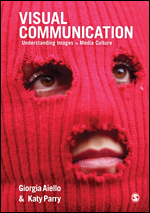
Visual Communication
Understanding Images in Media Culture
Giorgia Aiello - University of Bologna, Italy
Katy Parry - University of Leeds, UK
In today’s digital media environment we are creating and consuming more images than ever before. From the importance of image in politics, to the ubiquity of the ‘selfie’ across social media platforms, visual communication is increasingly central to our everyday mediated lives.
It is more important than ever to examine the social and cultural implications of mediated images – but how can we really interrogate the work that images do?
Visual Communication: Understanding Images in Media Culture provides a theoretical and empirical toolkit to do just that. It explores a range of approaches to visual analysis, while also providing a hands-on guide to applying a diverse range of methods to your own work. The book:
- Illustrates multiple perspectives, from content analysis and semiotics, to multimodal and critical discourse analysis.
- Explores the centrality of images to issues of identity and representation, politics and activism, and commodities and consumption.
- Brings theory to life with a host of original case studies, from celebrity videos on YouTube and civil unrest on Twitter, to the lifestyle branding of Vice Media and Getty Images.
- Shows you how to combine approaches and methods to best suit your own research questions and projects.
An invaluable guide to analysing contemporary media images, this is essential reading for students and researchers of visual communication and visual culture.
Available formats
See what’s new to this edition by selecting the Features tab on this page. Should you need additional information or have questions regarding the HEOA information provided for this title, including what is new to this edition, please email sageheoa@sagepub.com. Please include your name, contact information, and the name of the title for which you would like more information. For information on the HEOA, please go to http://ed.gov/policy/highered/leg/hea08/index.html.
For assistance with your order: Please email us at textsales@sagepub.com or connect with your SAGE representative.
SAGE
2455 Teller Road
Thousand Oaks, CA 91320
www.sagepub.com
Need 1: Visual culture is proliferating online. Students need teaching tools that reflect this and give them the tools to analyze these images in their own media experience.
Meeting need: Reviewers commented on the inclusion across the book of examples and case studies from digital and social media as strength that sets this book apart.
Need 2: Learning from a variety of approaches common in media studies research.
Meeting need: Built for media studies and drawing on examples resonant with media students, each case study provides a 'toolkit' approach walking students through an analytic technique or method, and how it can be applied to a particular image or visual context.